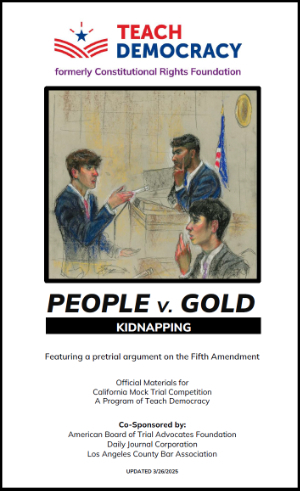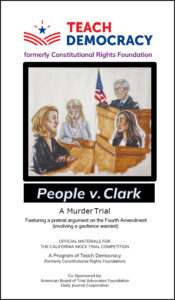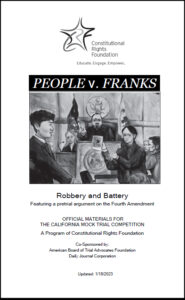Store
Mock Trial Cases
Grades 6 -12
Mock Trial s take students to the heart of the justice system. Students acquire critical-thinking skills and an in-depth understanding of our judicial process as they study a hypothetical case, conduct legal research, and role play the trial. Each Mock Trial packet includes a hypothetical case, witness statements, legal authorities, trial instructions, and procedural guidelines. It also includes a pretrial motion, designed to deepen student understanding of constitutional issues related to criminal trials.
Mock Trial E-Books.
Purchase mock trials cases ONLINE and DOWNLOAD them instantly. No need to wait for shipping. Look for the E-Book options for each title.
- Buy one copy, store the files on your computer and print as many as you need.
- Add any of our titles from this page to your online shopping cart, proceed to checkout, and when your order is complete, you will be emailed a receipt with a link to download your book.
- You will need Adobe Acrobat Reader to view your titles, it is most likely already installed on your computer.
Check out: People v. Meadows: A Mock Trial for the Classroom
(click on the Government tab above)
People v. Gold
Kidnapping
Featuring a pretrial arguments on the fifth amendment.
People v. Gold is the trial of Logan Gold, assistant campaign manager to their spouse, Harper Dorais (pronounced dō ∙ RAY), a candidate for city council in the town of Emerald Bend. Gold is also the owner of the only hotel in town. Gold is charged with the kidnapping of Taylor Alexander, a rival candidate to Dorais in the city council election.
A debate between the candidates was scheduled for Saturday, November 11, at noon, just three days before the election. When the debate was supposed to begin, however, Taylor Alexander did not show up. Dorais was present and Logan Gold arrived late. Later that afternoon the Emerald Bend Sheriff’s Department received a phone call from Alexander claiming Alexander had been kidnapped and held against their will.
The prosecution alleges that Logan Gold abducted Alexander on the morning of November 11 and under threat of violence, made Alexander drink a liquid that made Alexander unconscious. Alexander did not awake until the afternoon, after the scheduled debate. Alexander supported a measure to allow short-term rentals in Emerald Bend, which Gold opposed, giving Gold a motive to undermine Alexander’s campaign.
The defense argues that Logan Gold has an alibi and that Alexander may have faked the kidnapping in order to call into question Dorais’s and Gold’s reputations.
The testimonies of the county forensic investigator and the defense forensic expert will reveal different opinions about the evidence.
The pretrial hearing centers on a defense motion to exclude a potentially incriminating statement made by Logan Gold while in police custody.
People v. Clark
A Murder Trial
Featuring a pretrial argument on the Fourth Amendment (involving a geofence warrant)
People v. Clark is the trial of Tobie Clark, the in-house counsel for Sunshine Medical Components, Inc. (“SMC”), a billion-dollar medical technology company. Clark is charged with the first-degree murder of SMC’s chief executive officer, Kieran Sunshine.
On the morning of July 17, Kieran Sunshine’s dead body was found by Gerri Moayed in Kieran’s hotel suite. Kieran died from apparent stabbing. Moayed was Kieran’s personal holistic wellness coach and an employee of SMC.
The prosecution alleges that Tobie Clark murdered Kieran because Kieran was backing out of Clark’s plot to commit fraud against SMC’s board of directors regarding SMC’s latest product. Prosecution witnesses include Moayed, who occupied the room next to Kieran and overheard two arguments between Clark and Kieran, one of which occurred late at night on July 16. Emari Sunshine, Kieran’s sibling and an executive at SMC, reported having seen Tobie Clark heading toward Kieran’s suite around the time of the murder.
The defense argues that Tobie Clark did not have a motive to kill Kieran and never had the intent to murder or was inside Kieran’s suite. Furthermore, it was Kieran, not Clark, who concocted the plot to commit fraud, and Clark had no idea about the plot until July 16, when Clark refused to participate. A third Sunshine sibling, Arian, was also an executive at SMC and knew that it was Emari more than anyone else who stood to gain financially from Kieran’s death and that Emari had always felt animus toward Kieran.
The testimonies of the state medical examiner and the defense forensic expert reveal different opinions about the physical and forensic evidence.
The pretrial hearing is based on the Fourth Amendment protection against unreasonable search and seizure and centers on a defense motion to quash evidence garnered through a geofence warrant. Geofences are virtual boundaries around geographic areas created by signals from cellphones and mobile devices within the area. The geofence evidence appeared to place Tobie Clark near the crime scene.
People v. Franks
Robbery and Battery
Featuring a pretrial argument on the Fourth Amendment
People v. Franks is the trial of Jordan Franks, a young actor who finished a run of performances of the Shakespeare-adaptation Macbeth at Sea on a cruise ship. Franks is charged with robbery and battery of Franks’ fellow actor, Billie Scher.
The prosecution alleges that Franks was envious of Scher and an altercation occurred between Scher and Franks in the cabin they shared. Franks ran out of the room. Scher called 911 and reported that he had been violently shoved by Franks and that Franks stole Scher’s signet ring, a ring that Scher claimed was once owned by William Shakespeare. Scher also explained that Franks broke Scher’s arm during the robbery.
The defense argues that Jordan Franks neither removed Scher’s ring from the shared cabin nor used any intentional force against Scher. Franks will assert that he merely took his own cell phone from the cabin which bears a resemblance to the signet ring’s box. Franks will further assert that he did not shove Scher, but that Scher angrily stepped in front of Franks and caused an inevitable collision, resulting in Scher’s broken arm.
The pretrial argument centers on the Fourth Amendment protection against unreasonable search and seizure. The question is whether the police needed a warrant to search a safe in Franks’ closet.
People v. Cobey
Murder and Manslaughter
Featuring a pretrial argument on the Fourth Amendment
People v. Cobey is the trial of Jamie Cobey, a horticulturist living in a semi-rural town in the high desert. Cobey is charged with the homicide of Cobey’s landlord and next-door neighbor, Erik Smith. The prosecution will argue that Cobey should be convicted of first-degree murder or the lesser-included offense of voluntary manslaughter.
The relationship between Cobey and Smith had deteriorated in recent years with both engaging in unneighborly behavior. The tension between the two intensified once the pandemic eviction moratorium went into effect, and Smith wanted to evict Cobey and Cobey’s elderly mother for non-payment of rent. After Smith shut off the power to Cobey’s home, Cobey’s mother died on April 22. In the early afternoon of April 29, Erik Smith opened his mailbox and was bitten by a Mojave rattlesnake that was within the mailbox.
The prosecution alleges that on the morning of April 29, Jamie Cobey intentionally placed the rattlesnake with its rattle removed in Smith’s mailbox so that the snake would fatally bite Smith. Prosecution witnesses include a line worker who witnessed Cobey standing close to Smith’s mailbox that morning while Cobey held a small metal-wire cage. A neighbor will testify to seeing Cobey enraged at Smith at the funeral of Cobey’s mother the day before Smith’s death, as well as overhearing Cobey yell “I’m going to kill him!” later that evening in Cobey’s own garden. The medical examiner will testify to the severe lethality of the snake’s venom and the unlikelihood that the snake crawled by itself into the mailbox through a mail slot. The sheriff’s deputy will testify to finding several snake-handling items and books about desert snakes in Cobey’s home, as well as fingerprints of Cobey, Smith, and one other neighbor on Smith’s mailbox.
The defense argues that Jamie Cobey lacked the specific intent for first-degree murder, the sudden quarrel or heat of passion needed for voluntary manslaughter, and the act of placing the rattlesnake inside the mailbox. Defense witnesses include a herpetologist who will testify that other circumstances superseded the causal link between the bite and Smith’s death, especially Smith’s willful refusal to seek medical attention. The herpetologist will also testify that the snake more than likely squeezed itself into the mailbox. Another tenant of Smith will testify to Cobey’s even-tempered character and lack of hostility toward Smith before Smith’s death. A different neighbor and friend of Cobey will testify to Cobey’s habit of “cooling off” after outrageous actions by Smith, as well as the common knowledge about rattlesnakes crawling into mailboxes. Finally, Jamie Cobey will deny placing the snake in the mailbox and will testify that the items found by the sheriff’s deputy were everyday items for desert horticulturalists.
The pretrial argument centers on the Fourth Amendment protection against unreasonable search and seizure. The question is whether Erik Smith’s use of a smart camera provided by law enforcement to capture an image of snake-feeding tongs on the property of Jamie Cobey constituted a search under the Fourth Amendment and therefore required a search warrant, or whether it fell outside the warrant requirement.
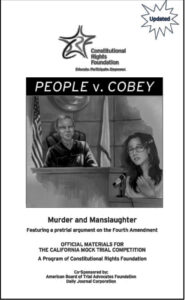
People v. Croddy
Burglary, Aiding and Abetting and Accessory After the Fact
Featuring a pretrial argument on the Fifth Amendment
People v. Croddy is the trial of Lee Croddy who hosts a popular YouTube channel. Croddy has been charged with two counts: (1) aiding and abetting in the commission of first-degree burglary by another, and (2) accessory after the fact. Croddy posts videos on Youtube in which Croddy discusses topics Croddy believes are suppressed by the government. One favorite topic of Croddy’s is government cover-ups related to UFOs. Croddy attracted the attention of an enthusiastic fan, Remi Montoya.
During a group chat, Croddy shared a short video clip that included an image of government documents. The documents contained personal information about an official named Drew Marshak who allegedly had information about UFOs. A few days later, Montoya stole a briefcase from Marshak’s home and copied files from Marshak’s computer. In a brief confrontation, Montoya hit Marshak in the face. Montoya later pleaded guilty to first-degree burglary and assault on a peace officer.
The prosecution alleges that Lee Croddy aided and abetted Montoya in the burglary. The prosecution will present evidence that Croddy showed a video with Marshak’s information to Montoya and others in the group chat while instructing Montoya to “take what’s ours” from Marshak and that Montoya acted under Croddy’s influence. The prosecution further alleges that Croddy let Montoya spend the night in Croddy’s home after the burglary, knowing that Montoya had committed a crime.
The defense argues that Lee Croddy did not knowingly aid or abet Montoya in any crime. The defense will present evidence that Croddy merely intended to build camaraderie within a political movement for government transparency through Croddy’s videos, chat messages, and text messages. The defense argues that Croddy did not have the intent to aid or abet Montoya’s criminal acts and had no knowledge of the crimes after they occurred, and so was not an accessory after the fact.
The pretrial issue centers on the Fifth Amendment protection against self-incrimination and as set forth in Miranda v. Arizona. The issue is whether or not the circumstances surrounding Lee Croddy’s interaction with the police amounted to custodial interrogation, requiring the officer to read Croddy the Miranda warnings prior to interrogation.
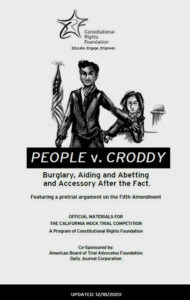
People v. Matsumoto
A Murder Trial. Featuring a pretrial argument on the Fourth Amendment
People v. Matsumoto is the trial of Bailey Matsumoto, the founder of a technology start-up that develops autonomous (self-driving) trucks. Bailey is charged with the murder of Bailey’s spouse, Taylor Matsumoto. The prosecution alleges that after Taylor’s son Michael died in a tragic accident using one of Bailey’s malfunctioning autonomous scooters, Taylor founded an organization called Parents Against Autonomous Driving (PAAD). Taylor’s involvement in PAAD began to financially impact Bailey’s business and Bailey’s and Taylor’s relationship rapidly deteriorated. Just days before Taylor was set to testify in support of a bill titled National Moratorium on Autonomous Technologies, Taylor was found dead, face down in Taylor’s bathtub. The prosecution claims that Bailey murdered Taylor with premeditation in order to prevent Taylor from testifying and to stop PAAD from succeeding. The defense argues that Taylor’s death was not a murder but was instead an unfortunate accident. The defense argues that when Taylor arrived home the night before Taylor’s body was found, Taylor was drunk and highly impaired from alcohol. Taylor proceeded to drink even more that evening and accidently slipped on spilled champagne, hit Taylor’s head on the bathtub trough, and drowned. The pretrial issue involves the Fourth Amendment protection against unreasonable searches and seizures.
People v. Klein
False Report of an Emergency and a Criminal Threat
People v. Klein is the trial of Reagan Klein. Reagan is charged with two felony counts: making a false report of an emergency (in this case, commonly referred to as “swatting”) and making a criminal threat. The prosecution alleges that Reagan threatened a coworker, Sawyer Smith, via a social media post and that Reagan had animosity against Sawyer because Sawyer had become a rising social-media influencer and because Sawyer was responsible for Reagan being fired from the restaurant where they both worked. The prosecution further argues that Reagan made a false “text-a-tip” to the police requesting police respond to a “hostage situation” at Sawyer’s residence. A SWAT team responded to the call, and Sawyer was seriously injured.
The defense argues that Reagan neither threatened Sawyer nor made the false text to the police. The defense further argues that Reagan had no more animosity toward Sawyer than other coworkers who all disliked Sawyer’s influencer personality and who had all engaged in the cyberbullying of Sawyer.
In the pretrial motion, the defense will argue that Reagan’s social media posts were not a “true threat,” and it is therefore protected free speech under the First Amendment.
People v. Davidson
A Murder Trial. Featuring a pretrial argument on the Fourth Amendment
Casey Davidson faces a felony count of first-degree murder for the death of Alex Thompson, a member of an extremist nationalist group. The prosecution alleges that Davidson murdered Thompson shortly after a political rally. After Thompson was punched at the rally and walked away, Davidson allegedly followed Thompson. A short time later, Thompson was found dead.
The prosecution alleges that Davidson willfully and deliberately struck Thompson and that Davidson had done so with premeditation, even posting threatening messages on a social network. The defense argues that Davidson did not murder Thompson and has an alibi for the time of death. According to the defense, Davidson was an activist in a nonviolent group and had a history of mediating during conflicts. The defense also argues that forensic blood evidence found on Davidson’s clothing was the result of Davidson’s close proximity to Thompson when Thompson was punched at the rally. The messages on the social network, the defense argues, were in one case the result of someone other than Davidson, and in another case, the result of Davidson responding to an incident in which Thompson physically injured Davidson.
The pretrial issue focuses on self-incrimination and on whether it is a search under the Fourth Amendment for the government to obtain routinely collected GPS location data from a third-party GPS provider.
People v Davidson Online Streaming Rental: 15 Days $5.95/ 30 Days $9.95 ![]()
People v. Awbrey
Human Trafficking and False Imprisonment – Featuring a pretrial argument on the Fourth and Fifth AmendmentsIn the trial of Cameron Awbrey, a restaurant owner, who is being charged with human trafficking and false imprisonment of Lin Stark, an immigrant. The prosecution alleges that Cameron targeted Lin to cook at Cameron’s restaurant, with the intent to obtain forced labor by depriving Lin of Lin’s personal liberty. The defense argues that Cameron was a hardworking, novice business owner and a concerned employer who was making an effort to help Lin maintain Lin’s work visa. The pretrial issue involves the Fourth and Fifth Amendments, namely protection against illegal search and seizure and against self-incrimination.
People v. Hayes
Murder
Protection against self-incrimination
Jamie Hayes, a student at Central Coast University, faces a felony charge of murder for the homicide of a campus security guard. Hayes is raising the affirmative defense of another in order to claim the homicide was justifiable. The prosecution alleges that Hayes struck the guard in the head with a baseball bat while the guard was lawfully restraining a fellow student. The defense argues that Hayes did strike the guard but had not formed the intent to commit a homicide. Pretrial issue: Statements made by Hayes during interrogation and the Fifth Amendment protection against self-incrimination
People v. Shem
Theft by larceny and consent to search
A graduate student in fine arts, defendant Evan Shem is a talented artist with a knack for recreating famous works of art. Shem is accused of stealing a painting from the art gallery where he interned and replacing it with a fake. Pretrial issue: Can Shem’s roommate consent to the search of a storage cabinet located in an unattached parking carport or did the search violate the Fourth Amendment protection against unreasonable searches and seizures.
People v Shem Online Streaming Rental: 15 Days $5.95/ 30 Days $9.95 ![]()
People v. Concha
Second-degree murder and possession with intent to sell a controlled substance.
Rae Concha, a high school student, is alleged to have sold controlled substance to other students on campus, and in particular that he sold to Jason Johnson with full knowledge that Jason suffered from a congenital heart defect and that the substance would be dangerous to Johnson. Rae Conchat is charged with second-degree murder, which is the unlawful killing of another human being with malice aforethought and with possession with the intent to sell a controlled substance. Pretrial issue: Was there was a search or seizure and whether the search or seizure was reasonable.
People v. Vega
Hit and run and custodial interrogation
Adrian Vega, an accomplished student athlete and child of the city’s mayor, is charged with felony hit and run following an accident. Police questioned Vega shortly after the accident without giving Miranda warnings. Police must issue these warnings to anyone in custody whom they question. Pretrial issue: Was the defendant in custody when questioned by the police?
Online Streaming Rental: 15 Days $5.95/ 30 Days $9.95![]()
People v. Buschell
Murder and the right to bear arms
A college student is found murdered at a festival’s campground, and police focus on a student rival who the murdered student was planning on reporting for violating the college’s honor code. When police make the arrest, the suspect is carrying a concealed weapon without a license. Pretrial issue: Is the state’s concealed carry statute constitutional?
Online Streaming Rental: 15 Days $5.95/ 30 Days $9.95 
People v. Woodson
Assault with a deadly weapon and free expression
A middle school student, new to town, is harassed at school and on the Internet. On the way home from school, the student is attacked from behind with a brick. Police arrest Jesse Woodson, a junior college student who had interned at the middle school for the attack and for violating an state law against bullying and cyberbullying. Pretrial issue: Is the anti-bullying law constitutional?
Online Streaming Rental: 15 Days $5.95/ 30 Days $9.95 ![]()
People v. Bratton
Murder and search and seizure
When a celebrity blogger is found murdered in his driveway, police arrest a comedian who the blogger had harshly criticized. Pretrial issue: Was the police’s search of the defendant’s computer within the scope of the warrant?
Online Streaming Rental: 15 Days $5.95/ 30 Days $9.95 ![]()
People v. Lane
Arson and free expression
A religious group buys land and stirs controversy in a small tourist town. Following a rally protesting the group’s presence in the community, a fire breaks out destroying the group’s community center. The leader of the protest rally is arrested for arson and incitement to commit an illegal act. Pretrial issue: Is the defendant’s song and conduct at the rally protected by the First Amendment?
Online Streaming Rental: 15 Days $5.95/ 30 Days $9.95![]()
People v. Palmer
Murder and scientific evidence
The day after a party, notorious Hollywood producer Jes Markson is found dead. Markson had been making a comeback after being found not guilty of murdering Taylor Rodriguez, Markson’s spouse. Markson’s former friend Alex Palmer is charged with first degree murder. Pretrial issue: Does a new “memory mapping” test meet the criteria to have its results admitted as scientific evidence?
People v. Campbell
Attempted school bombing and free expression
Police discovered a time bomb in a trash can near a high school’s lunch area. A student is charged with attempting to explode the device and possession of an illegal violent video game. Pretrial issue: Does the state’s law against violent video games violate the First Amendment to the U.S. Constitution?
Online Streaming Rental: 15 Days $5.95/ 30 Days $9.95 ![]()
People v. Markson
Murder and search and seizure
When the body of a Hollywood star is found, the spouse is charged with first-degree murder. Pretrial issues: Did the defendant’s consent to a search allow police to search a storage room?
People v. Kendall
Manslaughter, Illegal Contest of Speed, and Freedom of Speech and Association
A college student is accused of participating in a drag race that caused the death of another racer. Pretrial issue: Does the city’s anti-drag racing club ordinance violate the First Amendment?
People v. Kendall Online Streaming Rental: 15 Days $5.95/ 30 Days $9.95 ![]()
People v. Casco
Credit Card Fraud
A student is accused of buying items using other people’s credit card information and of selling the items to other students. Pretrial issue: Was a drug-dog search at school, which uncovered information from the defendant, constitutional?
Online Streaming Rental: 15 Days $5.95/ 30 Days $9.95
People v. Martin
Murder and self-incrimination
An honor student, involved in a cheating scandal, is accused of murdering a student who discovered the cheating and threatened to report it to the school. Pretrial issue: Did the police violate the defendant’s Fifth Amendment rights?
People v. Price
Arson and search and seizure A fire destroys a ski resort that was planning to expand into a wilderness area. An opponent of the expansion is arrested and charges with arson. Pretrial issue: Was a search of the defendant’s truck constitutional?
People v. Tanner
Homicide and memory reliability
A young adult’s 20-year-old memory of a sibling’s death sparks a police investigation leading to a murder charge. Pretrial issue: Should evidence of other violence be excluded because it is irrelevant and highly prejudicial?
See skilled students conduct People v. Tanner. Streaming Rental: 15 Days $5.95/ 30 Days $9.95 ![]()
People v. Brunetti
Homicide, conspiracy, the right to bear arms
Two students die in a schoolyard shooting —the victim and shooter. Police arrest the owner of the murder weapon. Pretrial issue: Is a statute regulating possession of assault weapons constitutional?
People v. Donovan (E-Book)
Involuntary manslaughter, removal of traffic sign, and the protection against self-incrimination
A fatal traffic accident occurs on a highway due to the theft of a “Do Not Enter” sign. Police arrest a college student, who makes incriminating statements following the postponement of a pretrial hearing. In a pretrial motion, students argue whether the incriminating statements are admissible in court.
People v. Caufield (E-Book)
Carjacking, three strikes, and due process
Following a carjacking, police locate the stolen car and arrest a suspect in a nearby house. Pretrial issue: Can a prior conviction be used at trial?
People v. Clevenger (E-Book)
Vandalism, computer crimes, search and seizure
Police arrest an honor student for vandalizing a school’s computer room and altering records. Pretrial issue: Was a search of the student’s locker legal?
People v. Kelmar (E-Book)
Youth violence, homicide, and privacy
When a high school senior shoots a fellow student and claims self-defense, a psychotherapist’s testimony becomes critical. In a pretrial motion, students argue whether the admission of such testimony violates the psychotherapist-patient privilege. Then at trial they examine the battered person syndrome and imperfect self-defense.
People v. Whitman (E-Book)
Child abduction, grant theft, and self-incrimination
When a young child is taken from a park, the non-custodial parent is charged with child abduction. In a pretrial motion, students argue whether the defendant’s Miranda rights were violated.
People v. Stover (E-Book)
Use of force, free expression, and hate crimes
This case involves a private security guard whose actions during an alleged break-in raises issues about the use of force, freedom of expression, and the elements of a hate crime. In a pretrial motion, students argue the constitutionality of a community ordinance governing racist expression.
People v. Mitchell (E-Book)
Alcohol abuse, responsible driving, and the exclusionary rule
A traffic accident results in charges of driving under the influence and felony hit-and-run. A pretrial motion addresses the constitutionality of a graphic stop based on police profile of a drunk driver.
People v. Haines (E-Book)
Gun control and homicide
Charges of possession of an unregistered assault weapon and voluntary manslaughter raises questions about reasonable fear and the right of self-defense. In a pretrial motion, students argue the constitutionality of a statue regulating possession of assault weapons.
People v. Friendly (E-Book)
Property, police, and privacy
The facts of this case revolve around charges of receiving stolen property and the battery of a police officer. Based on the Fourth and 14th amendments, students argue a pretrial motion to suppress evidence found during a police search of a residence.
People v. Coronel (E-Book)
Assault, state authority, and treaty rights
Set during the California gold rush, this case involves a charge of assault with a deadly weapon. A pretrial motion deals with the rights of a Mexican miner as detailed in the Treaty of Guadalupe Hidalgo, signed by President Polk in 1848.
People v. Dennis (E-Book)
School vandalism, computer crime, and privacy
Charges of vandalism and a computer crime raises issues of student rights. A pretrial motion applies the Fourth Amendment to a locker search.
People v. Willow (E-Book)
Issues of free expression and drug use
The distribution of an alternative newspaper and an exchange in a parking lot lead to charges of selling drugs and inducing a minor to take drugs. In a pretrial motion based on the First and 14th amedments, students argue whether speech and printed material praising crack cocaine are constitutionally protected.
People v. Rose (E-Book)
Poisoning, assault with a deadly weapon, and search and seizure
After two students are poisoned at a high school club initiation, police arrest a member of the “pledge class” who seems to have a motive of revenge for hazing and blackballing. Pretrial issues: Were the search of the student’s computer and seizure of computer files legal?
Criminal Justice in America, 5th Edition
Grades 9 – 12
The most comprehensive secondary criminal justice text. Now With Full Color Photographs, Charts, and Graphs
Our most popular publication, Criminal Justice in America is the most comprehensive secondary text available on the subjects of criminal law, procedure, and criminology. It can serve as a text for an entire law-related education course, or as a supplement for civics, government, or contemporary-issues courses.
Its extensive readings are supported by:
- Directed Discussions
- Role Plays
- Mock Trials
- Cooperative and Interactive Exercises
- Activities to Involve Outside Resource Experts
- Research Activities for Students to Use the Library or Internet
The Student Edition is divided into six units:
- Crime covers elements of crimes, violent crime, gangs, property crime, inchoate crimes, hate crimes, computer crimes, white-collar crime, crimes against the justice system, legal defenses, methods for measuring crime, victims’ rights, and the history of crime in America.
- Police explores local police, attitudes toward police, community policing, criminal investigations, forensic science, search and seizure, Miranda, the exclusionary rule, racial profiling, corruption, use of force, policing the police, and the history of law enforcement.
- The Criminal Case examines courts, judges, prosecutors, defense attorneys, plea bargaining, and the rights of criminal defendants. Most of the unit explores a hypothetical criminal case from arrest through trial.
- Corrections looks into sentencing, prisons, alternatives to prison, capital punishment, theories of punishment, the history of corrections, and debates such as those over crack-cocaine sentencing and the high number of persons behind bars.
- Juvenile Justice explores the separate system for juveniles and examines delinquency, status offenses, steps in a juvenile case, rights of juveniles, school searches, sentencing of juveniles, waiver to adult court, juvenile corrections, how the system developed, and current debates.
- Solutions looks at debates over the causes of crime, racism in the justice system, crime in schools, vigilantism, policy options to reduce crime and to make the system fairer, and options for individual citizens.
The Teacher’s Guide provides detailed descriptions of teaching strategies, suggested answers to every question in the text, activity masters, tests (for each chapter and unit and a final test), background readings, and extra resources to supplement the text.
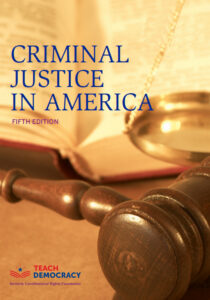
Criminal Justice in America, 5th Ed. Student Text – Paperback
(ISBN: 978-1-886253-46-9)
Criminal Justice in America, 5th Ed. Student Text – Digital Edition
(ISBN: 978-1-886253-46-9)
The student text is available on the Amazon Bookstore:
The teacher’s guide is sold and shipped by Teach Democracy (formerly Constitutional Rights Foundation). The teacher’s guide does not contain the student text.
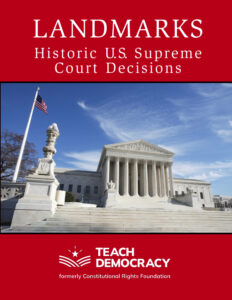
Landmarks: Historic U.S. Supreme Court Decisions
Grades 9–12
U.S. Supreme Court cases have greatly affected U.S. history. Let your students discover some of the most important cases. Each reading in the student text focuses on one case, giving historical background, outlining the decision, and explaining its significance.
A separate teacher’s guide contains lesson plans for each reading. The plans include focus activities, discussion questions with suggested answers, step-by-step instructions for interactive activities, and debriefing questions and suggestions.
The student text begins with a reading on how the Supreme Court works. The book continues with readings on important cases such as: Marbury v. Madison (1803) | McCulloch v. Maryland (1819) | Dred Scott v. Sandford (1857) | Brown v. Board of Education (1954) | Gideon v. Wainwright (1963) | Miranda v. Arizona (1966) | U.S. v. Nixon (1974) | Regents of UC v. Bakke (1978) | Texas v. Johnson (1989) | Bush v. Gore (2000)
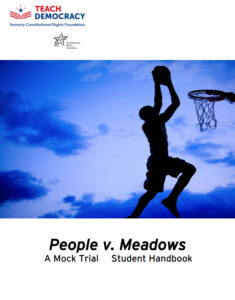
People v. Meadows
A Mock Trial Designed for the Classroom
Grades 6–12
This specially designed mock trial is perfect for engaging students in the classroom. The high-interest case involves a high school basketball game that got out of hand. A coach is arrested for aggravated assault against a referee. The two had a history of antagonizing one another with texting and posting pictures on the Internet.
The case of People v. Meadows is both an exciting mock trial and an informative lesson on the important right to privacy, perhaps one of the most debated rights in American society. Students engage in a criminal trial simulation and learn the fundamentals of due process, proof beyond a reasonable doubt, and the jury system.
The entire People v. Meadows package includes:
- A student handbook with instructions for jury selection, opening and closing arguments, direct and cross-examination of witnesses, and jury deliberation.
- Role descriptions for prosecutors, defense attorneys, judges, witnesses, and jurors.
- A complete mock trial with case facts, witness statements, and detailed teacher instructions for conducting the trial in almost any size classroom.
- “To Be Let Alone: Our Right to Privacy” : A complete lesson plan with a reading and interactive discussion activity about what is and is not private on the Internet.
People v. A. Wolf: A Mini-Mock Trial for the Classroom

The materials come a free copy of The True Story of the 3 Little Pigs! by A Wolf.
Grades 3-6
Based on the award-winning children’s book The True Story of the 3 Little Pigs: by A. Wolf by Jon Scieszka, this two-part simulation takes students through the process of selecting a jury and conducting a trial.
In the first simulation, students take the roles of attorneys, judge, and prospective jurors to learn about the jury selection process (voir dire). Roles for prospective jurors are based on traditional fairy tales and legends, reinforcing literacy skills including characterization
In the second part of the simulation, the courtroom drama unfolds as students take the roles of attorneys, witnesses, judge, and jurors to determine if the wolf is guilty of two counts of murder (one of the pigs survives the wolf’s visit).
Masters for handouts with instructions for the various roles are included. Also included is an introductory lesson, “Who’s Who In The Courtroom,” to acquaint students with the roles and responsibilities of judges, attorneys, jurors, and others involved in a courtroom proceeding.
Landmarks: Historic U.S. Supreme Court Decisions
Grades 9–12
U.S. Supreme Court cases have greatly affected U.S. history. Let your students discover some of the most important cases. Each reading in the student text focuses on one case, giving historical background, outlining the decision, and explaining its significance.
A separate teacher’s guide contains lesson plans for each reading. The plans include focus activities, discussion questions with suggested answers, step-by-step instructions for interactive activities, and debriefing questions and suggestions.
The student text begins with a reading on how the Supreme Court works. The book continues with readings on important cases such as: Marbury v. Madison (1803) | McCulloch v. Maryland (1819) | Dred Scott v. Sandford (1857) | Brown v. Board of Education (1954) | Gideon v. Wainwright (1963) | Miranda v. Arizona (1966) | U.S. v. Nixon (1974) | Regents of UC v. Bakke (1978) | Texas v. Johnson (1989) | Bush v. Gore (2000)
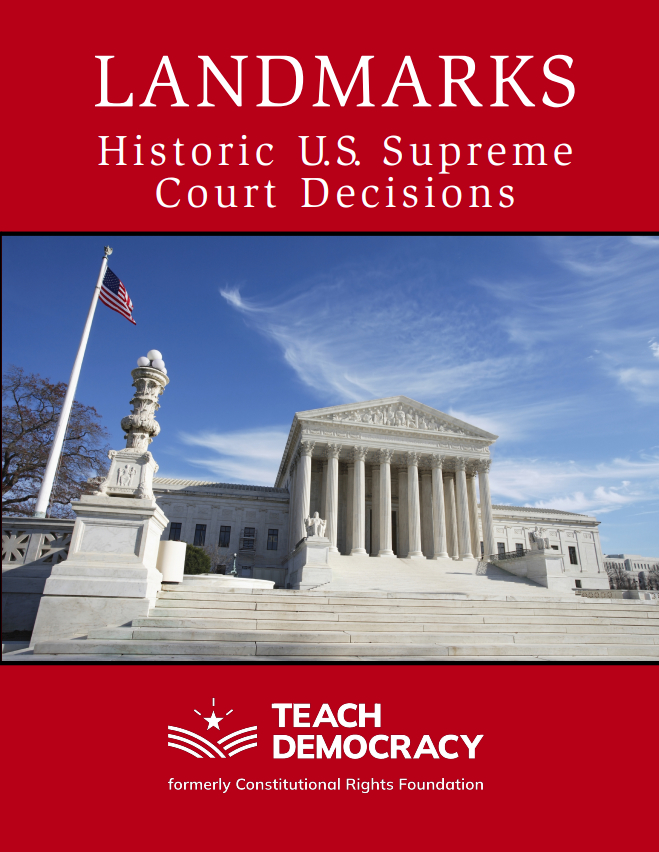
Adventures in Law and History, 2nd Edition
Upper-Elementary Grades
Takes your students on a trip through time to learn about law and civic education through motivating, interactive lessons. Adventures in Law and History Volumes I & II provide upper-elementary teachers with lessons set in American historical eras that introduce law-related concepts including the purpose and function of law, equal protection, and due process. Created in collaboration with elementary teachers, the curriculum provides role plays, simulations, readers theaters and other interactive methods to engage students in learning about history and law and to foster critical-thinking and cooperative-learning skills.
Each unit begins with an introductory lesson to provide students with historical background, followed by a sequence of lessons that send students on an imaginary voyage to the time period. Your students will grapple with law-related issues as they encounter fictional and historical characters and events that require them to apply problem-solving and critical-thinking skills. Each unit culminates with a lesson linking the historical and law-related content to the present and an activity providing an opportunity to engage youth in a service-learning project to build civic responsibility skills.
Both volumes of this illustrated curriculum feature step-by-step teaching procedures and reproducible worksheet and activity masters.
Adventures in Law and History I: Native Americans, the Spanish Frontier, and the Gold Rush
With introductory lessons for each unit to provide students with standards-based historical background.
Unit I: Students visit a Native American Chumash village and discover how rules and laws derived from myth and tradition help the Indians govern tribal life and resolve conflicts.
Unit II: Students meet Luisa, a girl living in a pueblo on the Spanish frontier. There, they explore the concept of property and how law helps resolve conflicts over property.
Unit III: Students experience a hypothetical mining camp in the Gold Rush era and discover what life might be like without effective authority. Students examine the role of the executive, the legislature, and the judiciary.
Adventures in Law and History II: Coming to America, Colonial America, and the Revolutionary Era
With standards-based introductory lessons for each unit to provide students with historical background.
Unit I: Using the methods of historiography, students trace the immigrant origins of five families whose ancestors came to America seeking opportunity and freedom and struggled for equality.
Unit II: Students, through the magic of time travel, visit a hypothetical New England village of the Colonial era and learn essential lessons about due process.
Unit III: Students explore the concepts of authority by helping a tired king rule his kingdom and view the causes of the American Revolution through the eyes of Bostonians as the colonies move toward independence.
Unit IV: Students learn about the rights and responsibilities of citizenship by helping Mr. Madison draft the Bill of Rights and also about the appropriate limits of those rights. Adventures in Law and History:
- Can be used separately or in sequence
- Are appropriate for ESL and sheltered-English students
- Support the California History-Social Science Framework and other elementary social studies course outlines
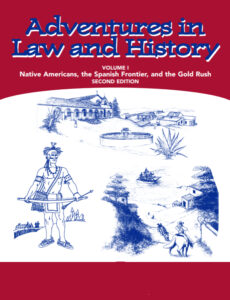
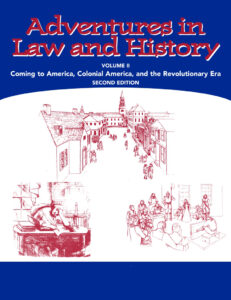
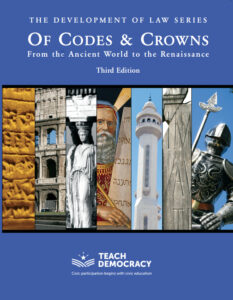
Of Codes & Crowns, Third Edition
From the Ancient World to the Renaissance
Linked to world history standards
Grades 9-12
One of our most popular texts returns in a new edition — Of Codes and Crowns is fully revised and updated. Featuring lessons with:
- Short, high-interest readings.
- Discussion questions to facilitate understanding.
- Interactive activities to foster critical thinking.
Unit 1: Hammurabi’s Treasure explores the concept of lex talionis, the law of retribution, and an ancient set of laws—The Code of Hammurabi.
Unit 2: Blood Feud discusses the Greek tribunal system and the myth of Orestes.
Unit 3: Jewish Law looks at the development of Jewish law, one of the foundations of Western legal tradition.
Unit 4: Roman Law traces the more than 1,000-year evolution of this law—from its beginnings in the city-state of Rome through the republic and empire.
Unit 5: Islamic Law looks at the origins and development of Islamic law.
Unit 6: Merry Old England examines the medieval English jury system, one far different from ours today.
Unit 7: The Magna Carta analyzes how the English got King John to limit the power of monarchs.
Unit 8: The Trial of Galileo explores the conflict between the greatest scientist of the time and church officials who believed his ideas clashed with church doctrine.
Teacher’s Guide
Of Codes & Crowns has an extensive teacher’s guide containing discussion questions and answers, and step-by-step instructions for the interactive lessons.
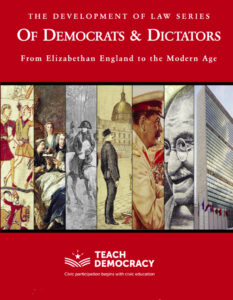
Of Democrats and Dictator
From Elizabethan England to the Modern Age
Linked to world history standards
Grades 9-12
Unit 1: Sir Edward Coke and the Common Law explores the development of the common law by focusing on one of its great proponents, Sir Edward Coke.
Unit 2: The Enlightenment Philosophers looks at four philosophers’ views on government and natural law—Hobbes, Locke, Montesquieu, and Rousseau.
Unit 3: The Code Napoleon explores the first modern code of laws, which became the model for legal systems in most other nations in the world.
Unit 4: The Dreyfus Affair examines the trials of the innocent man Alfred Dreyfus and the role the press played in his convictions and ultimate vindication.
Unit 5: The Totalitarians looks at the perversion of law under Hitler’s Nazi Germany and Stalin’s Soviet Union.
Unit 6: War Crimes focuses on the development of rules of war and the Nuremberg and Yamashita trials following World War II.
Unit 7: Gandhi and Civil Disobedience looks at Gandhi and the question of when it proper to disobey the law.
Unit 8: International Law traces the emergence of international law in the modern age and looks at its value and limitations.
Teacher’s Guide
An extensive teacher’s guide containing more than 20 lesson plans. The plans include focus activities, discussion questions with suggested answers, step-by-step instructions for interactive activities, and debriefing questions and suggestions.
Return/Refund
If for any reason an item does not meet your needs, simply return it in good condition with a copy of our invoice or packing slip for credit or refund. You do not need prior authorization to return your purchase.
Shipping and Delivery
All orders are shipped from our office in Los Angeles, California. Please allow 5 to 10 days for delivery. Delivery time is calculated based upon business days and does not include weekends. Please allow one full day for order processing. Should you require priority shipping service, you will be able to request it at checkout. We ship all orders by UPS ground service or United States Postal Service Priority Mail. If for any reason your order is delayed we will notify you via e-mail.
Your shipping charge will be determined by your delivery location. At checkout, you will be presented with various shipping options including regular or priority shipping.
Sale/Usage Taxes
If we do not collect sales tax from you, you may still owe sales tax on your purchase. Your state may require purchasers to report and pay tax on all purchases that are not taxed at the time of sale. For more information, please visit your state’s tax agency website.
Online Security
When you order from teachdemocracy.org, you’ll join the thousands of customers who have safely purchased items from us.
Our shopping cart service uses secure server software (SSL) for secure commerce transactions. It encrypts all of your personal information, including credit card number, name, and address, so that it cannot be read as the information travels over the Internet. For additional information, please see our Privacy Policy.
PDF Help Center
What happens when I purchase a PDF Book?
When you purchase a PDF Book, you will be provided with a digital version of the PDF Book for immediate use. If you haven’t already downloaded the Adobe Acrobat Reader® for PDF files , please click on the link and do so now. If you have installed the reader, you can use the PDF link that comes up automatically after your order has been confirmed. You will also receive the link and code to open the PDF in a follow-up e-mail that you will receive shortly after your order is completed.
You can choose to download this digital version to any computer or device you choose. The link will be available for up to four weeks from the date of your order and then it will expire. Once you have downloaded and saved your PDF Book, you will be able to open it using the Adobe Acrobat Reader® for PDF files and the code supplied whenever you need to view or print it. You will probably wish to back-up your PDF Book to another source, such as a CD-ROM or Internet based storage system to protect against data loss in the event of a hard drive crash.
What do I need to get started?
Before purchasing the PDF Book, you need the following:
Internet access
A valid e-mail address
A computer or device to receive the PDF Book. Be sure to check to see if your computer meets the system requirements to install the free Adobe Acrobat Reader® for PDF files.
How do I download a PDF Book?
Downloading a PDF Book is easy!
Make sure you have the latest version of the Adobe Acrobat Reader® for PDF files installed on your computer (or at least version 4.0 or above).
Browse our titles, select the PDF Books you want, and add them to your shopping cart.
When you have finished shopping, click the “Proceed to Checkout” button on the shopping cart page. Follow the on-screen instructions to complete the transaction. (You will not be charged for shipping on your PDF Books).
At the completion of the order you will receive a link on a confirmation Web page which you can use to download your title(s) and the code to open the PDF(s). Only use this link if you have already downloaded and installed the reader. You will also receive a link to the file and the code in a follow-up email notice. If you do not want to use the file on the computer that you ordered it on you may want to forward the email confirmation to an account on the computer where you want to be able to view and print the file.
To save each PDF Book, you can either right-click on the link and choose “Save Target [or Link] As” or left-click on the link to open it in your browser and then save the link directly from your browser. Opening the link in your browser does not automatically save the PDF Book to your computer. You must take the additional step of saving it to your computer. Use File> Save As or the disk icon near the top of your browser to save your PDF Book from your browser.
Back to Top
How are PDF Books secured?
The PDF Books are secured using Adobe security, they can be printed, but cannot be modified in any way.
Do I have to be connected to the Internet every time I want to view my PDF Book?
No. Once you have obtained the rights to access a PDF Book, you will be able to enjoy that content off-line, without being connected to the Internet.
Will I have the ability to print hard copies of the PDF Books that I have downloaded?
Yes. Our PDF Books are designed to be printed. Please see individual titles for printing and copying restrictions. In the Adobe Acrobat Reader® for PDF files, you can find the print key by clicking on “File” and then “Print” or clicking on the printer icon at the top of the reader. If your PDF Book will not print, please visit the Adobe Acrobat Reader® for PDF files Customer Support Web site and search for troubleshooting information about your problem. If you are still unable to resolve your printing issue, email crf@crf-usa.org with details about the problem (including your printer type).
Can I edit my PDF Book electronically?
You are not able to make any changes to the pdf. Copying and pasting text and pictures from the PDF Book is also not permitted.
Can I back up my PDF Books to protect against loss in the event that my hard drive crashes?
Yes, it is a good idea to back up your PDF Book files so that if your computer crashes, you can reinstall your PDF Books when your computer is fixed. Simply save a copy of your PDF Book(s) to another source.
When will my ability to view my PDF Book expire?
PDF books are yours to keep indefinitely.
What if I run into trouble and need help?
For any technical questions, other than those relating to your reader, please contact us. If you have questions about or problems with the Adobe Acrobat Reader® for PDF files, please visit the Acrobat PDF Book Reader Customer Support Web site.
Can I return a PDF Book?
If you are not 100% satisfied with your electronic purchase there is no need to “return” the downloaded book. Simply contact us by email at publications@teachdemocracy.org for a full refund or credit.
Contact
Address:
Teach Democracy
601 South Kingsley Drive
Los Angeles, CA 90005
Office Hours: Monday – Friday, 9:00 a.m – 5:00 p.m.
Phone: 213-487-5590
E-Mail: publications@teachdemocracy.org
